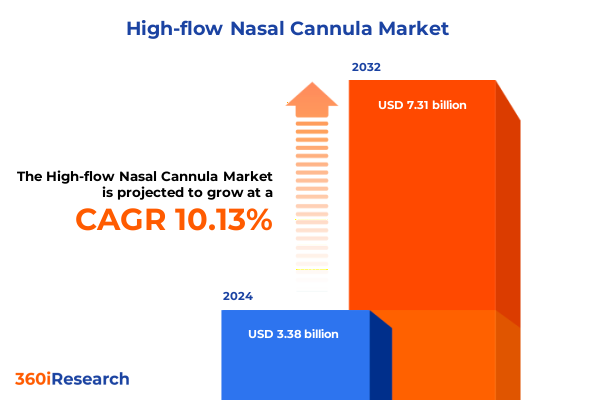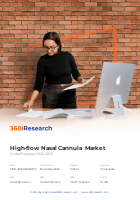The High-flow Nasal Cannula Market size was estimated at USD 3.38 billion in 2024 and expected to reach USD 3.70 billion in 2025, at a CAGR of 10.13% to reach USD 7.31 billion by 2032.

Understanding the Evolution and Clinical Importance of Heated Humidified High-Flow Nasal Cannula in Modern Respiratory Care
High-flow nasal cannula therapy has emerged as a cornerstone of modern respiratory care, offering a non-invasive alternative to traditional oxygen delivery systems. Across the United States, nearly 16 million adults are diagnosed with chronic obstructive pulmonary disease, highlighting a significant and growing demand for effective oxygenation solutions. By delivering heated, humidified oxygen at high flow rates, HFNC systems enhance patient comfort, reduce airway dryness, and provide a degree of positive end-expiratory pressure that facilitates improved gas exchange.
Key Drivers Shaping High-Flow Nasal Cannula Adoption: Technological Innovation, Non-Invasive Care, and Home Healthcare Expansion
In recent years, healthcare providers have witnessed transformative shifts in how respiratory support is administered. Non-invasive modalities like high-flow nasal cannula therapy have gained traction in intensive care units, with global usage in ICUs increasing by 38% in 2023 as clinicians seek to minimize intubation-related complications. These devices deliver precise oxygen concentrations, and clinical studies have demonstrated a 22% reduction in intubation rates when HFNC is applied compared to conventional therapies.
Analyzing the Complex Ramifications of 2025 U.S. Tariff Adjustments on Medical Device Supply Chains and High-Flow Nasal Cannula Availability
In early 2025, the United States implemented a comprehensive tariff package imposing a universal 10% duty on all medical device imports, with higher reciprocal tariffs for certain trading partners-20% on European exports and punitive rates of 54% on goods from mainland China. These measures disrupt established supply chains for critical HFNC components such as heated humidifiers and specialized tubing.
Decoding Market Segmentation Dynamics Impacting High-Flow Nasal Cannula Utilization Across Clinical, Home, and Distribution Settings
The high-flow nasal cannula market is distinguished by multifaceted segmentation that influences device design, clinical application, and distribution strategies. Devices are engineered either for single use or multiple cycles of cleaning and reprocessing, catering to varying hospital policies on infection control and cost management. Flow rates are calibrated to meet clinical protocols, with some systems delivering up to 60 liters per minute and others optimized for lower thresholds to balance patient comfort with therapeutic efficacy.
This comprehensive research report categorizes the High-flow Nasal Cannula market into clearly defined segments, providing a detailed analysis of emerging trends and precise revenue forecasts to support strategic decision-making.
- Product Type
- Flow Rate
- Component
- Age Group
- Oxygen Source
- End User
- Application
- Distribution Channel
Examining Regional Variations in High-Flow Nasal Cannula Demand and Adoption Patterns Across Americas, EMEA, and Asia-Pacific
Regional adoption of high-flow nasal cannula therapy varies significantly across major global markets. In the Americas, advanced healthcare infrastructure and a high burden of chronic respiratory diseases drive robust utilization, accounting for over 40% of global device uptake in 2023. Europe, the Middle East, and Africa exhibit moderate growth as critical care units in established healthcare systems integrate HFNC alongside non-invasive ventilation in emergency and post-operative settings, contributing approximately 28% of worldwide demand. Meanwhile, the Asia-Pacific region represents the fastest-growing market segment, with installations increasing by 32% year-on-year as government investments and rising prevalence of pulmonary disorders spur expansion across China, India, and Southeast Asia.
This comprehensive research report examines key regions that drive the evolution of the High-flow Nasal Cannula market, offering deep insights into regional trends, growth factors, and industry developments that are influencing market performance.
- Americas
- Europe, Middle East & Africa
- Asia-Pacific
Profiling Leading High-Flow Nasal Cannula Manufacturers and Their Strategic Innovations Driving Market Differentiation
Fisher & Paykel Healthcare has reported record operating revenue exceeding $2 billion in FY 2025, driven in part by the introduction of advanced Optiflow+ nasal cannula featuring Evaqua™ condensate management and a universal dual connector compatible with the Airvo 2 and 3 systems, enhancing mobility for interdepartmental transfers and prolonged therapy sessions. Philips has strategically withdrawn the high-flow therapy software option for its V60 ventilators in the U.S. to focus development on dedicated Airvo systems, while simultaneously leading medical innovation with AI-enabled imaging and cloud-based monitoring platforms that complement standalone HFNC therapies. ResMed’s AcuCare™ high flow nasal cannula leverages dual-strap headgear technology for rapid fitting and stability, underscoring the company’s emphasis on usability and patient comfort in both acute and homecare environments. Vapotherm’s portfolio emphasizes portable HFNC solutions and telemedicine integration, targeting homecare growth and real-time remote monitoring to support longitudinal respiratory management. Dräger’s HI-Flow Star system offers integrated swivel connectors, disposable patient interfaces, and seamless interoperability with the Evita Infinity V500 ventilator, reflecting a commitment to reducing setup time and maintaining continuous therapy in critical care settings.
This comprehensive research report delivers an in-depth overview of the principal market players in the High-flow Nasal Cannula market, evaluating their market share, strategic initiatives, and competitive positioning to illuminate the factors shaping the competitive landscape.
- Allied Medical Limited
- Armstrong Medical Limited
- BMC Medical Co., Ltd.
- Drägerwerk AG & Co. KGaA
- Fairmont Medical Products Pty Ltd.
- Fisher & Paykel Healthcare Corporation Limited
- Flexicare (Group) Limited
- Great Group Medical Co., Ltd.
- Guangdong Pigeon Medical Apparatus Co.,Ltd.
- Hamilton Medical AG
- Heka Medicals India Private Limited
- ICU Medical, Inc.
- Koninklijke Philips N.V.
- Masimo Corporation
- MEKICS Co., Ltd.
- Narang Medical Limited
- nice Neotech Medical Systems Pvt. Ltd.
- ResMed, Inc.
- Sterimed Group
- SunMed, LLC
- Synergy Intact Private Limited
- Teleflex Incorporated
- Vapotherm, Inc.
- Vyaire Medical, Inc.
- Well Lead Medical Co., Ltd.
Actionable Strategies for Industry Leaders to Navigate Regulatory, Supply Chain, and Technological Challenges in HFNC Deployment
To maintain continuity of supply amid evolving tariff regimes, industry leaders should diversify sourcing by qualifying alternative manufacturing hubs across North America, Europe, and Southeast Asia. Establishing multi-tier supplier agreements for key components such as blenders and humidifiers can mitigate the impact of sudden duty increases. Investing in clinician education programs-both digital and in-person-will accelerate adoption of advanced HFNC protocols and ensure optimal utilization of device features. Furthermore, aligning product roadmaps with emerging tele-respiratory trends and sustainable design practices can unlock new revenue streams in homecare and ambulatory settings.
Comprehensive Research Methodology Leveraging Primary Interviews, Secondary Data, and Triangulation for High-Flow Nasal Cannula Insights
This analysis synthesizes insights from structured primary research, including in-depth interviews with pulmonologists, respiratory therapists, and supply chain executives across leading health systems. Secondary research encompassed a review of peer-reviewed clinical studies from the National Library of Medicine and tariff documentation from the Office of the U.S. Trade Representative. Data triangulation was applied by cross-referencing corporate financial disclosures, third-party industry surveys, and government import records to validate trends and quantify the operational impact of policy shifts. Rigorous methodological protocols ensure transparency, traceability, and alignment with best practices in healthcare market intelligence.
This section provides a structured overview of the report, outlining key chapters and topics covered for easy reference in our High-flow Nasal Cannula market comprehensive research report.
- Preface
- Research Methodology
- Executive Summary
- Market Overview
- Market Insights
- Cumulative Impact of United States Tariffs 2025
- Cumulative Impact of Artificial Intelligence 2025
- High-flow Nasal Cannula Market, by Product Type
- High-flow Nasal Cannula Market, by Flow Rate
- High-flow Nasal Cannula Market, by Component
- High-flow Nasal Cannula Market, by Age Group
- High-flow Nasal Cannula Market, by Oxygen Source
- High-flow Nasal Cannula Market, by End User
- High-flow Nasal Cannula Market, by Application
- High-flow Nasal Cannula Market, by Distribution Channel
- High-flow Nasal Cannula Market, by Region
- High-flow Nasal Cannula Market, by Group
- High-flow Nasal Cannula Market, by Country
- Competitive Landscape
- List of Figures [Total: 36]
- List of Tables [Total: 951 ]
Concluding Insights on the Transformative Impact of High-Flow Nasal Cannula on Respiratory Care Innovation and Market Growth
High-flow nasal cannula therapy stands at the forefront of non-invasive respiratory support, reflecting a paradigm shift toward patient-centric care. As clinical protocols evolve, multidisciplinary collaboration has been pivotal in refining device capabilities, from enhanced humidification technologies to integrated digital monitoring. The interplay of regulatory changes, such as 2025 U.S. tariffs, underscores the critical importance of supply chain resilience. Meanwhile, regional growth patterns and segmentation dynamics signal opportunities for tailored strategies in device development and market engagement. By embracing innovation, forging strategic partnerships, and investing in education, stakeholders can sustain momentum and drive the next wave of HFNC adoption across diverse care settings.
Collaborate with Ketan Rohom for Exclusive Access to In-Depth High-Flow Nasal Cannula Market Research and Strategic Guidance
To gain comprehensive insights and strategic guidance on the high-flow nasal cannula market, we invite you to connect with Ketan Rohom, Associate Director of Sales & Marketing. Engaging with Ketan will provide you with personalized assistance, tailored data packages, and expert interpretation of the report’s key findings. Whether you are evaluating market entry strategies, assessing emerging segments, or seeking to optimize supply chains under evolving tariffs, Ketan offers the industry expertise and consultative support necessary to inform critical decisions. Don’t miss the opportunity to leverage this deep dive analysis and position your organization at the forefront of respiratory care innovation. Reach out today to secure your copy of the market research report and embark on a path to sustainable growth.

- How big is the High-flow Nasal Cannula Market?
- What is the High-flow Nasal Cannula Market growth?
- When do I get the report?
- In what format does this report get delivered to me?
- How long has 360iResearch been around?
- What if I have a question about your reports?
- Can I share this report with my team?
- Can I use your research in my presentation?




